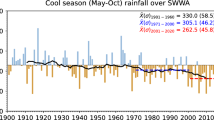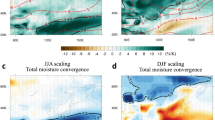Abstract
Precipitation in austral autumn and winter has declined over parts of southern and especially southwestern Australia in the past few decades1,2,3,4. According to observations and climate models, at least part of this decline is associated with changes in large-scale atmospheric circulation1,2,5,6,7,8,9,10,11,12,13,14, including a poleward movement of the westerly winds and increasing atmospheric surface pressure over parts of southern Australia. Here we use a high-resolution global climate model to analyse the causes of this rainfall decline. In our simulations, many aspects of the observed regional rainfall decline over southern and southwest Australia are reproduced in response to anthropogenic changes in levels of greenhouse gases and ozone in the atmosphere, whereas anthropogenic aerosols do not contribute to the simulated precipitation decline. Simulations of future climate with this model suggest amplified winter drying over most parts of southern Australia in the coming decades in response to a high-end scenario of changes in radiative forcing. The drying is most pronounced over southwest Australia, with total reductions in austral autumn and winter precipitation of approximately 40% by the late twenty-first century.
This is a preview of subscription content, access via your institution
Access options
Subscribe to this journal
Receive 12 print issues and online access
$259.00 per year
only $21.58 per issue
Buy this article
- Purchase on Springer Link
- Instant access to full article PDF
Prices may be subject to local taxes which are calculated during checkout



Similar content being viewed by others
Change history
17 July 2014
In the version of this Letter originally published online, in Fig. 2a and b the text labels relating to the years were swapped. This has now been corrected in all versions of the Letter.
References
Nicholls, N. Detecting and attributing Australian climate change: A review. Aust. Meteorol. Mag. 55, 199–211 (2006).
Timbal, B. & Fawcett, R. A historical perspective on southeastern Australian rainfall since 1865 using the instrumental record. J. Clim. 26, 1112–1129 (2013).
Risbey, J. S., Pook, M. J. & McIntosh, P. C. Spatial trends in synoptic rainfall in southern Australia. Geophys. Res. Lett. 40, 3781–3785 (2013).
Hope, P., Timbal, B. & Fawcett, R. Associations between rainfall variability in the southwest and southeast of Australia and their evolution through time. Int. J. Climatol. 1360–1371 (2010)
Cai, W. & Cowan, T. SAM and regional rainfall in IPCC AR4 models: Can anthropogenic forcing account for southwest Western Australian winter rainfall reduction? Geophys. Res. Lett. 33, L24708 (2006).
Hendon, H. H., Thompson, D. W. J. & Wheeler, M. C. Australian rainfall and surface temperature variations associated with the southern hemisphere annular mode. J. Clim. 20, 2452–2467 (2007).
Meneghini, B., Simmonds, I. & Smith, I. N. Association between Australian rainfall and the southern annular mode. Int. J. Climatol. 27, 109–121 (2007).
Nicholls, N. Local and remote causes of the southern Australian autumn-winter rainfall decline, 1958–2007. Clim. Dynam. 34, 835–845 (2009).
Timbal, B. et al. Understanding the Anthropogenic Nature of the Observed Rainfall Decline Across South Eastern Australia CAWCR Technical Report No. 026 (Centre for Australian Weather and Climate Research, 2010).
Timbal, B., Arblaster, J. M. & Power, S. Attribution of the late-twentieth-century rainfall decline in southwest Australia. J. Clim. 19, 2046–2062 (2006).
Cai, W., Cowan, T. & Thatcher, M. Rainfall reductions over Southern Hemisphere semi-arid regions: The role of subtropical dry zone expansion. Sci. Rep. 2, 702 (2012).
Cai, W., Purich, A., Cowan, T., van Rensch, P. & Weller, E. Did climate change induced rainfall trends contribute to the Australian millennium drought? J. Clim. 27, 3145–3168 (2014).
Purich, A., Cowan, T., Min, S-K. & Cai, W. Autumn precipitation trends over southern hemisphere midlatitudes as simulated by CMIP5 models. J. Clim. 26, 8341–8356 (2013).
Cai, W., van Rensch, P., Borlace, S. & Cowan, T. Does the southern annular mode contribute to the persistence of the multidecade-long drought over southwest western Australia? Geophys. Res. Lett. 38, L14712 (2011).
Hope, P. K., Drosdowsky, W. & Nicholls, N. Shifts in the synoptic systems influencing southwest Western Australia. Clim. Dynam. 26, 751–764 (2006).
Murphy, B. F. & Timbal, B. A review of recent climate variability and climate change in southeastern Australia. Int. J. Climatol. 28, 859–879 (2008).
Larsen, S. H. & Nicholls, N. Southern Australian rainfall and the subtropical ridge: Variations, interrelationships, and trends. Geophys. Res. Lett. 36, L08708 (2009).
Williams, A. A. J. & Stone, R. C. An assessment of relationships between the Australian subtropical ridge, rainfall variability, and high-latitude circulation patterns. Int. J. Climatol. 29, 691–709 (2009).
Thompson, D. W. J. et al. Signatures of the Antarctic ozone hole in Southern Hemisphere surface climate change. Nature Geosci. 4, 741–749 (2011).
Delworth, T. L. et al. Simulated climate and climate change in the GFDL CM2.5 high-resolution coupled climate model. J. Clim. 25, 2755–2781 (2012).
Delworth, T. L. et al. GFDL’s CM2 global coupled climate models. Part I: Formulation and simulation characteristics. J. Clim. 19, 643–674 (2006).
Gergis, J. et al. On the long-term context of the 1997–2009 ‘Big Dry’ in south-eastern Australia: Insights from a 206-year multi-proxy rainfall reconstruction. Climatic Change 111, 923–944 (2012).
Arblaster, J. M., Meehl, G. A. & Karoly, D. J. Future climate change in the Southern Hemisphere: Competing effects of ozone and greenhouse gases: SH climate change-ozone versus GHGs. Geophys. Res. Lett. 38, L02701 (2011).
Anderson, J. L. et al. The new GFDL global atmosphere and land model AM2–LM2: Evaluation with prescribed SST simulations. J. Clim. 17, 4641–4673 (2004).
Meinshausen, M. et al. The RCP greenhouse gas concentrations and their extensions from 1765 to 2300. Climatic Change 109, 213–241 (2011).
Harris, I., Jones, P. D., Osborn, T. J. & Lister, D. H. Updated high-resolution grids of monthly climatic observations-the CRU TS3.10 dataset. Int. J. Climatol. 34, 623–642 (2013).
Raupach, M. R. et al. Australian Water Availability Project (AWAP) CSIRO Marine and Atmospheric Research Component: Final Report For Phase 3 CAWCR Technical Report No. 013 (Bureau of Meteorology and CSIRO, 2009).
Jones, D. A., Wang, W. & Fawcett, R. High-quality spatial climate data-sets for Australia. Aust. Meteorol. Oceanogr. J. 58, 233–248 (2009).
Schneider, U. et al. GPCC full data reanalysis version 6.0 at 0.5°: Monthly land-surface precipitation from rain-gauges built on GTS-based and historic data. (2011)10.5676/DWD_GPCC/FD_M_V6_050
Bretherton, C. S., Widmann, M., Dymnikov, V. P., Wallace, J. M. & Blade, I. The effective number of spatial degrees of freedom of a time-varying field. J. Clim. 12, 1990–2009 (1999).
Acknowledgements
The authors are grateful to K. Findell and A. Wittenberg for very helpful comments on an earlier version of this manuscript.
Author information
Authors and Affiliations
Contributions
T.L.D. designed the simulations, conducted most of the analyses and wrote the manuscript. F.Z. conducted the simulations including data post-processing, and contributed to the analysis and writing of the manuscript.
Corresponding author
Ethics declarations
Competing interests
The authors declare no competing financial interests.
Supplementary information
Supplementary Information
Supplementary Information (PDF 1500 kb)
Rights and permissions
About this article
Cite this article
Delworth, T., Zeng, F. Regional rainfall decline in Australia attributed to anthropogenic greenhouse gases and ozone levels. Nature Geosci 7, 583–587 (2014). https://doi.org/10.1038/ngeo2201
Received:
Accepted:
Published:
Issue Date:
DOI: https://doi.org/10.1038/ngeo2201
This article is cited by
-
Sensitivity of extreme precipitation to climate change inferred using artificial intelligence shows high spatial variability
Communications Earth & Environment (2023)
-
The role of internal variability and external forcing on southwestern Australian rainfall: prospects for very wet or dry years
Scientific Reports (2023)
-
Drivers of accelerated warming in Mediterranean climate-type regions
npj Climate and Atmospheric Science (2023)
-
Caves demonstrate decrease in rainfall recharge of southwest Australian groundwater is unprecedented for the last 800 years
Communications Earth & Environment (2023)
-
Estimating future rainfall distributions in a changing climate for water resource planning: Victoria, Australia
Climate Dynamics (2023)



